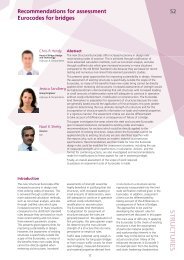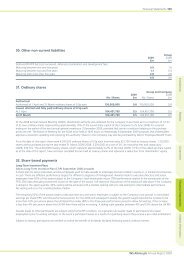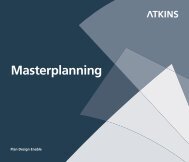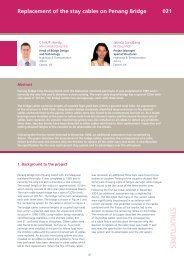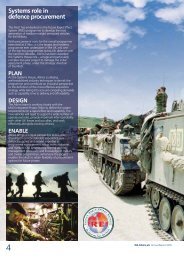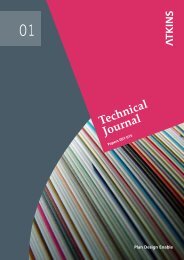View - Atkins
View - Atkins
View - Atkins
Create successful ePaper yourself
Turn your PDF publications into a flip-book with our unique Google optimized e-Paper software.
Financial Statements 71<br />
The results, assets and liabilities of Joint Ventures are stated in accordance with Group accounting policies. Where Joint Ventures adopt<br />
accounting policies that are different from the Group, their reported results are restated to comply with the Group’s accounting policies.<br />
Where Joint Ventures do not adopt accounting periods that are coterminous with the Group’s, results and net assets are based upon<br />
unaudited accounts drawn up to the Group’s accounting reference date.<br />
PPP/PFI concessions<br />
Assets constructed by PPP/PFI concession companies are classified in the accounts of the Joint Ventures as financial assets or intangible<br />
assets, depending on whether the grantor or user has the primary responsibility to pay the operator for the concession services. To date<br />
all of the Group’s PPP/PFI concession assets have been classed as financial assets.<br />
The financial asset represents an interest-bearing, long-term receivable. The cost of the financial asset at any one time is equal to the<br />
accumulated value of service delivery plus accumulated interest charged to the financial asset less amounts received to date.<br />
The financial asset is measured at fair value. Where it is classed as a loan receivable any movement in fair value is taken to the income<br />
statement. Where it is classed as available for sale any movement in fair value is taken to reserves.<br />
Revenue is recognised at the fair value of the consideration received for goods and services provided in the normal course of business<br />
net of value added tax rebates and discounts. Revenue from contracting activities represents the value of work carried out during the<br />
year including amounts not invoiced. Interest income is accrued on a time basis by reference to the principal outstanding and the<br />
effective interest rate applicable, which is the rate that exactly discounts estimated future cash receipts through the expected life of the<br />
financial asset to that asset’s net carrying value amount.<br />
Where the outcome of a construction contract can be measured reliably, revenue and costs are recognised by reference to the stage<br />
of completion of the contract activity at the balance sheet date as measured by the contract costs incurred. Where the outcome of a<br />
construction contract cannot be estimated reliably, contract revenue is recognised to the extent that it is probable that contract costs<br />
incurred will be recovered.<br />
When it is probable that the total contract costs will exceed total contract revenue, the expected resultant loss is recognised as an<br />
expense immediately.<br />
Income tax<br />
Current and deferred income tax are recognised in the income statement for the period except where the taxation arises as a result<br />
of a transaction or event that is recognised directly in equity. Income tax arising on transactions or events recognised directly in equity<br />
is charged or credited directly to equity.<br />
Deferred income tax is provided in full, using the liability method, on temporary differences arising between the tax bases of assets and<br />
liabilities and their carrying amounts in the consolidated Financial Statements. However, the deferred income tax is not accounted for if it<br />
arises from initial recognition of an asset or liability in a transaction other than a business combination that at the time of the transaction<br />
affects neither accounting nor taxable profit or loss. Deferred income tax is determined using tax rates (and laws) that have been<br />
enacted or substantially enacted by the balance sheet date and are expected to apply when the related deferred income tax asset is<br />
realised or the deferred income tax liability is settled.<br />
Deferred income tax assets are recognised to the extent that it is probable that future taxable profit will be available against which the<br />
temporary differences can be utilised.<br />
No deferred tax is recognised on the unremitted earnings of overseas subsidiaries and Joint Ventures.<br />
Intangible assets<br />
Goodwill<br />
Goodwill is stated at cost less impairment. Prior to 1 April 2004, goodwill was amortised over its estimated useful economic life.<br />
Amortisation ceased on 1 April 2004 and the carrying value of existing goodwill was frozen at that date and subject to annual<br />
impairment review.<br />
On acquisition of a business, fair values are attributed to the assets, liabilities and contingent liabilities of the acquired business at the<br />
date of acquisition. Goodwill arises when the fair value of the consideration given for a business exceeds the fair value of the net assets.<br />
In accordance with IFRS 3, Business combinations, goodwill arising on acquisitions is capitalised and is subject to impairment review<br />
both annually and when there are indications that the carrying value may not be recoverable.<br />
Goodwill that arose prior to 1 April 1997 was written off to retained earnings/loss. Profit or loss on disposal of the underlying businesses<br />
to which this goodwill related will not include goodwill previously recorded as a deduction from equity.<br />
Introduction Reviews Governance Financial Statements Investor Information<br />
WS <strong>Atkins</strong> plc Annual Report 2008




